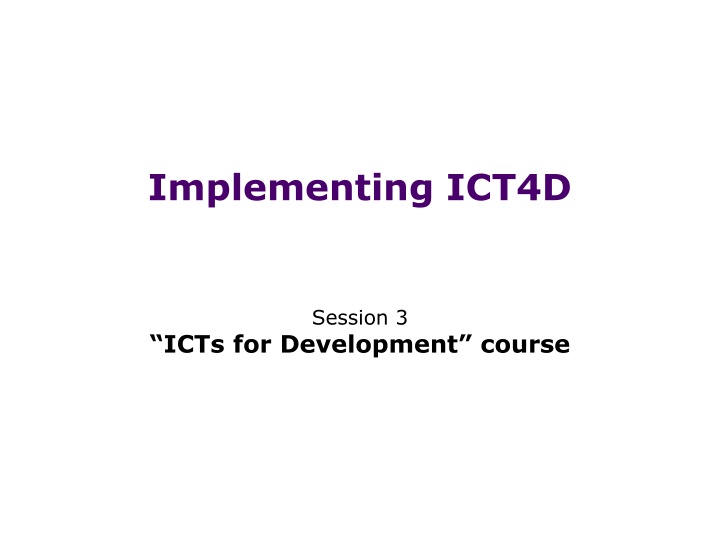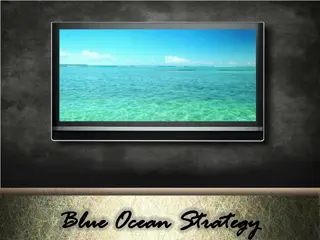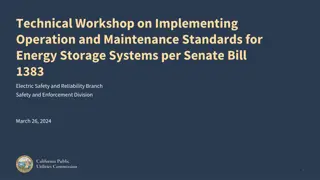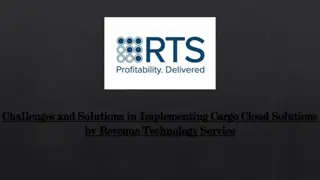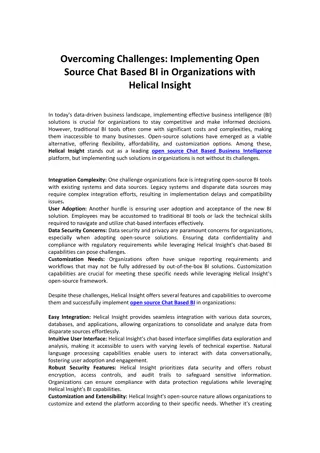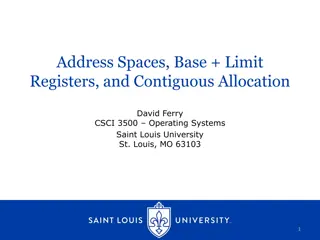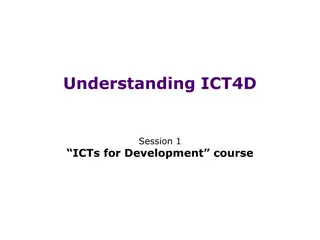Implementing ICT4D
Explore the ICT4D value chain, exogenous factors, impacts, and the steps involved in ICT4D strategy implementation and evaluation. Understand the technical and social architecture, project evaluation outcomes, and the challenges faced in achieving ICT4D objectives.
Download Presentation

Please find below an Image/Link to download the presentation.
The content on the website is provided AS IS for your information and personal use only. It may not be sold, licensed, or shared on other websites without obtaining consent from the author.If you encounter any issues during the download, it is possible that the publisher has removed the file from their server.
You are allowed to download the files provided on this website for personal or commercial use, subject to the condition that they are used lawfully. All files are the property of their respective owners.
The content on the website is provided AS IS for your information and personal use only. It may not be sold, licensed, or shared on other websites without obtaining consent from the author.
E N D
Presentation Transcript
Implementing ICT4D Session 3 ICTs for Development course
The ICT4D value chain Exogenous factors Enablers Intermediates/d eliverables -Locations (e.g. telecentres) -ICTs (e.g. PC, mobile, tablet) -Software applications Development impacts -Public goals (e.g. SDGs) - Other impacts (intended and unintended) Precursors -Data systems -Legal -Institutional -Human -Technological -Leadership & vision -Drivers/demand Inputs Outputs Outcomes -Financial and other quantitative benefits -Qualitative benefits -Disbenefits -Data -Money -Labour and knowledge -Technology -Values and motivations -Political support -Goals and objectives -New communication patterns -New information and decisions -New actions and transactions Strategy Implementation Adoption Use Sustainability Scalability Constraints IMPACT UPTAKE READINESS AVAILABILITY Richard Heeks, GDI, University of Manchester, UK Adapted from Heeks 2014b
Overview of ICT4D strategy Where do we want to get to? Where are we now? Where do we want to get to? Richard Heeks, GDI, University of Manchester, UK
1. Create ICT4D planning structures/roles Steps of ICT4D strategy 2a. Audit current ICT4D 2b. Get guidance from wider strategy 3. Set ICT4D objectives and principles 4a. Determine ICT4D technical architecture 4b. Determine ICT4D social architecture 5. Disseminate and plan ICT4D actions 6. Manage, evolve and review ICT4D strategy Richard Heeks, GDI, University of Manchester, UK Adapted from Heeks 2006a
ITPOSMO checklist and design reality gaps Technical architecture Information Information Technology Technology Processes Processes Social architecture Objectives and values Objectives and values Staffing and skills Staffing and skills Management systems and structures Other resources Management systems and structures Other resources Reality Design Richard Heeks, GDI, University of Manchester, UK Gap Adapted from Heeks 2002b
ICT4D technical architecture Telecommunications Data Data ICT Hardware management Software Data flow ICT4D technical architecture Development processes Richard Heeks, GDI, University of Manchester, UK
ICT4D project evaluation World Bank ICT projects with the objective to directly promote target access for the underserved and the poor had limited success; only 30 percent have achieved their objectives. (IEG 2011:xiv) We follow the prospects of 36 private telecenters which were opened at various times between November 2001 and February 2004. By May 2005, 32 of these 36 telecenters had closed. (Best & Kumar 2008:31) Of the papers examined, 70% (28 of the 40) referred to or reflected on some level of failure or unintended negative outcomes related to the use, uptake, or adoption of ICTs in developing communities. (Dodson et al. 2013:23) Richard Heeks, GDI, University of Manchester, UK
Principles for digital development EXERCISE: Select one principle that you feel is most important. Why is that the most important? Richard Heeks, GDI, University of Manchester, UK Image source: http://digitalprinciples.org/
ICT4D Project designreality gap actions Evaluate size of design reality gaps Identify problematically large gaps Take action to close those gaps Richard Heeks, GDI, University of Manchester, UK
The ICT4D prime question What s in it for me? Richard Heeks, GDI, University of Manchester, UK
Diffusion of Innovations curves Richard Heeks, GDI, University of Manchester, UK Image source: https://en.wikipedia.org/wiki/Diffusion_of_innovations#/media/File:Diffusion_of_ide as.svg
Diffusion of Innovations attributes Relative advantage Compatibility Complexity Trialability Observability Richard Heeks, GDI, University of Manchester, UK
ICT4D evaluation overview For When? Whom? How? (1) Pilot & Action Why? What? How? (2) Richard Heeks, GDI, University of Manchester, UK
Changing focus for ICT4D evaluation over time Level of ICT4D activity Impact - micro-outputs - outcomes - development contribution Uptake - demand - usage - use divide Availability - supply - implementation Readiness - awareness - infrastructure - digital divide Time Richard Heeks, GDI, University of Manchester, UK Adapted from Heeks 2009a and Heeks 2014b
Increasing complexity of ICT4D evaluation Multi- stakeholder Multi- method Multi-goal Single method Single goal Richard Heeks, GDI, University of Manchester, UK
ICT4D evaluation issues Perception vs. reality Whose evaluation? Unintended outcomes Negative outcomes Attribution Richard Heeks, GDI, University of Manchester, UK
Perspectives on ICT4D impacts and causes Optimism ( It will be good ) Impacts associated with ICT4D Mixed ( It will be good and bad ) Pessimism ( It will be bad ) Technological determinism ( ICTs cause ) Socio-technical contingency ( It depends ) Social determinism ( Society causes ) Causes of impacts associated with ICT4D Richard Heeks, GDI, University of Manchester, UK Adapted from Heeks 1999
